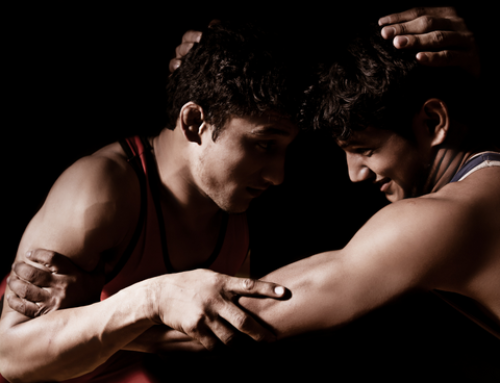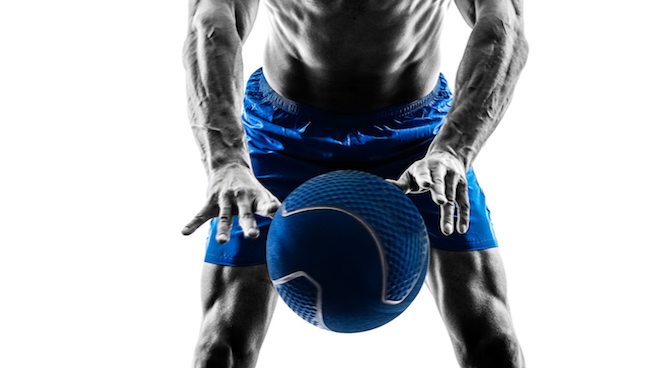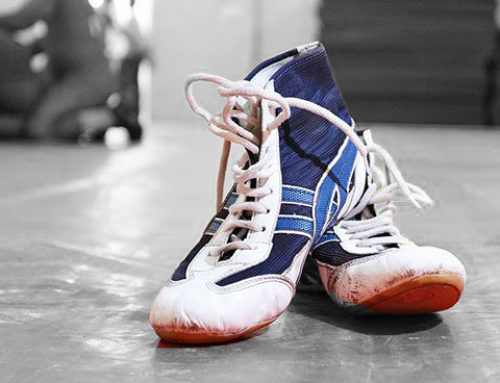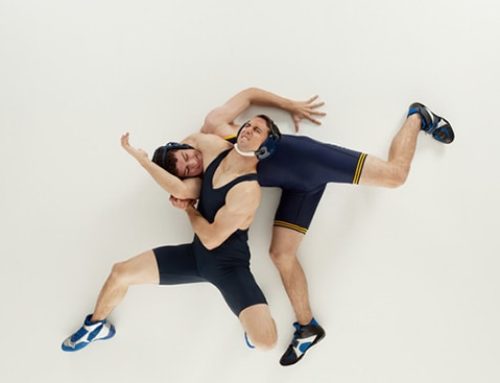5 Ways To Prevent Hockey Injuries
Newsflash!
Hockey injuries are preventable! But prevention cannot be guessed.
What follows is a summary of pointers that coaches & captains of teams can share with their membership.
5 Ways To Prevent Hockey Injuries
1: Stretching
Develop your own preferred set of repetitions (“reps”), but there are a set of six movements that this author does every day. Each has helped to keep minor and major injuries out of the picture.
The knees, ankles, lower back, hips, neck, shoulders, elbows, wrists & fingers are areas of need.
From a standing position, these stretches can be done either on the floor (on one’s back). Or preferably (time allowing) in both positions. A stretching band can be used for added muscle tension or without any equipment if none is available.
It may surprise some to read “fingers” on this list, but hand injuries are indeed common. The hand has the largest number of muscles in the human body, so it does deserve some controlled movement. Wrist flexes with weights can address this preventive need to keep a firm finger & thumb grip. Squeeze balls are often used to keep the hand more nimble.
Exercise the ankles, knees, hips, and back/spine with a stretching band or loop:
A gym pad/mat or other smooth padded surface is desirable.
First Stretch
- Lay flat on your back.
- Place the stretching band under both feet.
- Grip the other side of this circular band with both hands.
- The tension (pounds of pressure) of hand & arm-to-foot & leg resistance is what is needed to generate stronger muscle fiber with its supportive tissues.
- Draw or pull your feet in (knee becomes flexed) toward the center of your body until your feet reach your crotch area. Push feet back outward, using hands to supply resistance during motion.
- The back should remain flat without any arching.
- Start with a count of 10 repetitions (“reps”), then increase a few reps each day, until you build up to a count of about 200–or whatever you can do without feeling stressed.
Second Stretch
- With both heels/feet on the floor from a prone position (face up) draw both feet upward, use the stretch band to pull up both feet & legs.
- Move both hands on the stretch band upward as close to feet as possible, to increase hand and arm tension.
- Pull feet over abdomen and head for a backstretch, where legs are hanging over one’s head.
- If the feet can be pulled over the head to the floor, that is an excellent stretch for the spine.
- Lightly pull the feet down toward the floor, with the hands tugging in a slight bouncing motion.
Third stretch
- In the standing position, pull the stretch band outward as far as possible.
- Spread the feet about three feet apart, with knees bent.
- Holding that tension with arms apart, twist the abdomen/torso from left to right in a repeated smooth motion, keeping the head pivoted forward.
2: Warm-ups & Warm-downs
Stretch with cardio-burst before and after-game stretches
Cardio burst beforehand: After the initial stretching routine (above), do some jump rope or jumping jacks, on a realistically set number or a set time interval. The purpose is to get the heart pumping (especially in the morning) to create a more alert game participant.
Start with a small objective, such as 30 jumping jacks or 30 loops of jump rope at a time. Increase the repetitions (“reps”) in reasonable increments. Increase the count by ten, until you can feel a “training effect” of feeling some muscle fatigue or out-of-breath sensations. It is best not to “push it”, but instead keep the increments/rep increases going.
3: Weight Training
Train with strap-on wrist weights and strap-on ankle weights to build muscle, bone, tendon, and ligament capacity strength.
First, decide on the appropriate weight for your body size. weights can be from two pounds to five pounds.
With the added weight, your body works harder to “compensate” whenever there is any movement. It is common for some skaters to add five-pound (or less) ankle weights and also wrist weights in practice times–for that added edge in game situations. Anyone who does this form of adaptation has reported feeling more agile, faster, and stronger because of that weight-added training.
These devices can and should be considered for any age & stage of development above the age of puberty.
4: Wraps and Sleeves
Braces & wraps are commercially available and are not too expensive. These devices are sometimes called “orthotics” and can be considered for any age & stage of development.
Use athletic wraps/sleeves/braces for [in no particular order] knees, ankles, hips, elbows, shoulders, wrists–but not neck braces! Why? If someone needs a neck brace, they should not be playing in either game or practice situations!
The popular “metallic” sounding brand of athletic brace has good product quality (this is not a paid endorsement!). Start to use such supports at the first sign of achiness, not when there is excruciating pain. That ache is your body’s way of telling you to address the pain, perhaps also with over-the-counter topical cremes. These external devices help to compensate for the momentary instances or extended times of excessive pressure on that specific bone joint & associated muscles, tendons, and ligaments.
In the heat of play, that wrap/sleeve/brace can be the difference between a sprain or strain, or being able to “play on” without interruption.
All possible impact points during contact “sessions” need rigid forms of equipment parts. Examples in hockey include hockey pants, shoulder guards, elbow guards, groin protection, and knee guards. In recent years, “shot-blockers” for skates have prevented many bruises and even bone fractures. Hockey helmets and face guards have progressed considerably for risk reduction of brain concussion, broken noses, loss of teeth, jaw fractures, etc. On the controversial issue of full-face guards versus visors, all it takes is one slap shot to quickly convince anyone on the ice! Lost teeth and broken jaws/cheekbones are a consequence of not wearing the available protective equipment.
5: Hydrate
Under the concept of adequate hydration and increased alertness, it’s arguably not cheating to include, even with its mild diuretic effect: coffee!
Milk (or almond milk/coconut milk)–and no sugar added–for all of the well-known nutritional reasons.
For those early morning workouts, whether it is a darker or light drink, this popular beverage is known to have positive health benefits, at least for those over eighteen years of age.
Like common teas, this drink is safer (even if not “decaf”) than some of the questionable sports energy drinks currently on the market.
If coffee, tea, or milk are not one’s preference, consider 100% fruit juices. If a juicer is owned at home, that’s even better to bring homemade mixes to the game or practice time, to replenish.
Of course, pure water has merits, although it is possible to over-hydrate. Calculate from your body weight (male or female) to figure out how many ounces /milliliters of water/fluid you need to replenish what is being lost in sweat and exhalation. There are hydration apps available for iphones and other cellphone brands. Such calculations account for gender and body weight.
In conclusion
Regardless of the athlete’s chronological age, the present-day trend (based on validated scientific research) is to pay some attention to each of these aspects of injury prevention.
New coaches could even print out this STACK.com article and distribute it to team members and their parents.
RECOMMENDED FOR YOU
5 Ways To Prevent Hockey Injuries
Newsflash!
Hockey injuries are preventable! But prevention cannot be guessed.
What follows is a summary of pointers that coaches & captains of teams can share with their membership.
5 Ways To Prevent Hockey Injuries
1: Stretching
Develop your own preferred set of repetitions (“reps”), but there are a set of six movements that this author does every day. Each has helped to keep minor and major injuries out of the picture.
The knees, ankles, lower back, hips, neck, shoulders, elbows, wrists & fingers are areas of need.
From a standing position, these stretches can be done either on the floor (on one’s back). Or preferably (time allowing) in both positions. A stretching band can be used for added muscle tension or without any equipment if none is available.
It may surprise some to read “fingers” on this list, but hand injuries are indeed common. The hand has the largest number of muscles in the human body, so it does deserve some controlled movement. Wrist flexes with weights can address this preventive need to keep a firm finger & thumb grip. Squeeze balls are often used to keep the hand more nimble.
Exercise the ankles, knees, hips, and back/spine with a stretching band or loop:
A gym pad/mat or other smooth padded surface is desirable.
First Stretch
- Lay flat on your back.
- Place the stretching band under both feet.
- Grip the other side of this circular band with both hands.
- The tension (pounds of pressure) of hand & arm-to-foot & leg resistance is what is needed to generate stronger muscle fiber with its supportive tissues.
- Draw or pull your feet in (knee becomes flexed) toward the center of your body until your feet reach your crotch area. Push feet back outward, using hands to supply resistance during motion.
- The back should remain flat without any arching.
- Start with a count of 10 repetitions (“reps”), then increase a few reps each day, until you build up to a count of about 200–or whatever you can do without feeling stressed.
Second Stretch
- With both heels/feet on the floor from a prone position (face up) draw both feet upward, use the stretch band to pull up both feet & legs.
- Move both hands on the stretch band upward as close to feet as possible, to increase hand and arm tension.
- Pull feet over abdomen and head for a backstretch, where legs are hanging over one’s head.
- If the feet can be pulled over the head to the floor, that is an excellent stretch for the spine.
- Lightly pull the feet down toward the floor, with the hands tugging in a slight bouncing motion.
Third stretch
- In the standing position, pull the stretch band outward as far as possible.
- Spread the feet about three feet apart, with knees bent.
- Holding that tension with arms apart, twist the abdomen/torso from left to right in a repeated smooth motion, keeping the head pivoted forward.
2: Warm-ups & Warm-downs
Stretch with cardio-burst before and after-game stretches
Cardio burst beforehand: After the initial stretching routine (above), do some jump rope or jumping jacks, on a realistically set number or a set time interval. The purpose is to get the heart pumping (especially in the morning) to create a more alert game participant.
Start with a small objective, such as 30 jumping jacks or 30 loops of jump rope at a time. Increase the repetitions (“reps”) in reasonable increments. Increase the count by ten, until you can feel a “training effect” of feeling some muscle fatigue or out-of-breath sensations. It is best not to “push it”, but instead keep the increments/rep increases going.
3: Weight Training
Train with strap-on wrist weights and strap-on ankle weights to build muscle, bone, tendon, and ligament capacity strength.
First, decide on the appropriate weight for your body size. weights can be from two pounds to five pounds.
With the added weight, your body works harder to “compensate” whenever there is any movement. It is common for some skaters to add five-pound (or less) ankle weights and also wrist weights in practice times–for that added edge in game situations. Anyone who does this form of adaptation has reported feeling more agile, faster, and stronger because of that weight-added training.
These devices can and should be considered for any age & stage of development above the age of puberty.
4: Wraps and Sleeves
Braces & wraps are commercially available and are not too expensive. These devices are sometimes called “orthotics” and can be considered for any age & stage of development.
Use athletic wraps/sleeves/braces for [in no particular order] knees, ankles, hips, elbows, shoulders, wrists–but not neck braces! Why? If someone needs a neck brace, they should not be playing in either game or practice situations!
The popular “metallic” sounding brand of athletic brace has good product quality (this is not a paid endorsement!). Start to use such supports at the first sign of achiness, not when there is excruciating pain. That ache is your body’s way of telling you to address the pain, perhaps also with over-the-counter topical cremes. These external devices help to compensate for the momentary instances or extended times of excessive pressure on that specific bone joint & associated muscles, tendons, and ligaments.
In the heat of play, that wrap/sleeve/brace can be the difference between a sprain or strain, or being able to “play on” without interruption.
All possible impact points during contact “sessions” need rigid forms of equipment parts. Examples in hockey include hockey pants, shoulder guards, elbow guards, groin protection, and knee guards. In recent years, “shot-blockers” for skates have prevented many bruises and even bone fractures. Hockey helmets and face guards have progressed considerably for risk reduction of brain concussion, broken noses, loss of teeth, jaw fractures, etc. On the controversial issue of full-face guards versus visors, all it takes is one slap shot to quickly convince anyone on the ice! Lost teeth and broken jaws/cheekbones are a consequence of not wearing the available protective equipment.
5: Hydrate
Under the concept of adequate hydration and increased alertness, it’s arguably not cheating to include, even with its mild diuretic effect: coffee!
Milk (or almond milk/coconut milk)–and no sugar added–for all of the well-known nutritional reasons.
For those early morning workouts, whether it is a darker or light drink, this popular beverage is known to have positive health benefits, at least for those over eighteen years of age.
Like common teas, this drink is safer (even if not “decaf”) than some of the questionable sports energy drinks currently on the market.
If coffee, tea, or milk are not one’s preference, consider 100% fruit juices. If a juicer is owned at home, that’s even better to bring homemade mixes to the game or practice time, to replenish.
Of course, pure water has merits, although it is possible to over-hydrate. Calculate from your body weight (male or female) to figure out how many ounces /milliliters of water/fluid you need to replenish what is being lost in sweat and exhalation. There are hydration apps available for iphones and other cellphone brands. Such calculations account for gender and body weight.
In conclusion
Regardless of the athlete’s chronological age, the present-day trend (based on validated scientific research) is to pay some attention to each of these aspects of injury prevention.
New coaches could even print out this STACK.com article and distribute it to team members and their parents.










